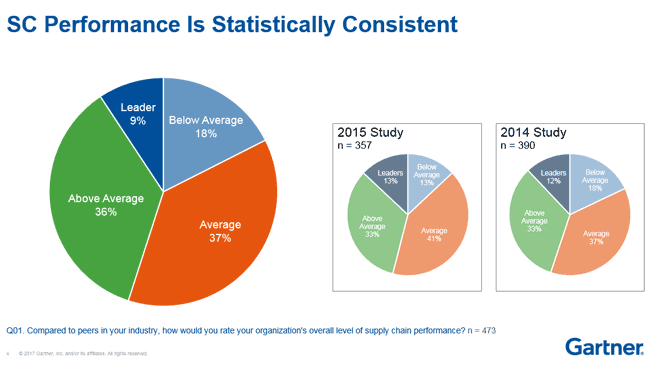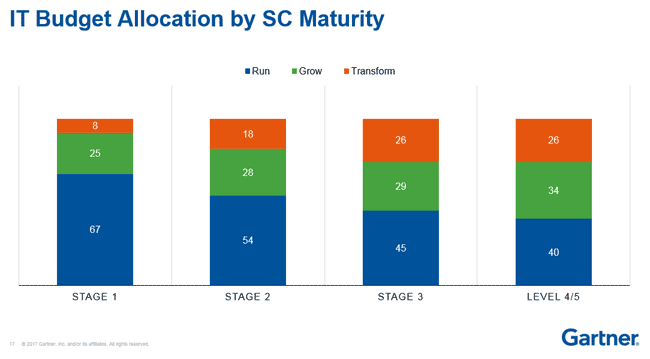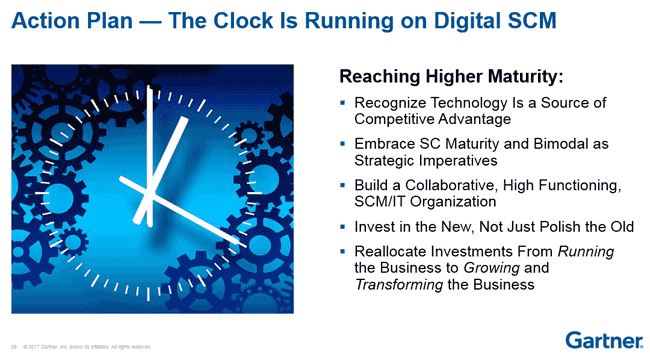I am just back from a "Megatrends" presentation for hardware store chain/co-op True Value during its core carrier meeting, led by John Bowersox, son of legendary supply chain academic Dr. John Bowersox of Michigan State.
It was a good time, and while I obviously can't report what I heard there, the chain is getting supply chain religion in a number of areas, and making rapid and quantifiable strides. Hope to tell the True Value story some day.
For 10 years now SCDigest has partnered with the analysts at Gartner on a supply chain study based on a survey of our readership.
While the research was conducted earlier in the year, it was again sort of unvelied in a big way in May at the Gartner Supply Chain Executive Conference in Phoenix, with the research led as usual by Gartner's Dwight Klappich.
Gilmore Says.... |
 |
| The fourth point comes in part from data from the survy showing big differences the state of the relationships and level of collaboration between the supply chain and the IT functions across companies. |
 |
What do you say? |
|
| Click here to send us your comments |
| |
|
|
|
As important context, a lot of what Gartner does these days is connected in some way to an ever-growing list of "maturity models," the first of which was a core supply chain framework, or more accurately a "Demand Driven Value Network " (DDVN) maturity model.
Released several years ago, the original model had four levels, but has now expanded to five. The basic concept has been spun out to similar maturity models for Sales & Operations Planning, Logistics and a few more areas.
If you aren't familiar with that DDVN model, the five levels are: Level 1 - React (business unit focused, often misaligned or siloed objectives); Level 2 - Anticipate (some supply chain functional performance improvements over Level 1); Level 3 - Integrate (integrated, cross functional supply chain decision-making); Level 4 - Collaborate (profitable demand-driven fulfillment through internal and some external collaboration); and Level 5 - Orchestrate (profitable shared value creation through innovation across internal/external networks).
Gartner will tell you very few if any companies are really at level 5, though some companies certainly rate themselves there.
That maturity model almost always becomes important with Gartner research and analysis because survey respondents are asked to self-rate themselves as being in one of those five levels, and then many of the responses are analyzed based on that segmentation. In this survey, 13% said they were Level 1, 31% Level 2, 37% Level 3 and 15% Level 4, and just 4% Level 5, but that was up from 1% last year.
As is almost an iron rule, companies tend to overrate their supply chain prowess, as indicated in the chart below,which is primarly meant to show the self-ratings have been consistent over time.

So why did I make the comment about overrating supply chain performance? Because again this year, a combined 45% rated their performance as above average, versus just 18% below average. While I suppose it's possible that the SCDigest reader responses that drive this survey are in fact from above average performers, my guess is the obvious rule that just 50% can really be above average and the other 50% below applies here too. The "50% problem," I have called it in the past.
So returning to the use of the maturity model to analyze other responses, the chart below looks at how respondents say companies spend their supply chain IT budgets by level of Gartner maturity.

As can be seen, companies at lower levels of supply chain maturity tend to spend a lot more of their available IT budgets on "running the business" than they do on "gowing the business" or "transforming the business" versus more mature companies. The implication of course is that this will eventually put the lower maturity companies at a competitive disadvantage.
So why is this? Seems to me there are three possibilities: (1) lower maturity companies simply spend less on supply chain IT, and so innovation is just cut out of the dollar pool; (2) lower maturity companies are less efficient in IT spend, so they have to spend relatively more just to keep the ship moving; or (3) lower maturity companies just lack an innovation gene overall in their supply chain or even total company DNA, so it isn't a high priority.
I would be interested in your take on this.
Finally for this column, at the end of the day, what are Gartner's recommendations for improving supply chain performance?
As seen in the slide below, top of the list is to first recognize that technology really can deliver competitive advantage in supply chain - and that company's doubt that proposition to their peril.

The second point has to do first with getting serious above assessing and then improving your company's level of supply chain maturity, and next adopting what Gartner calls a "bi-modal" supply chain strategy - pursuing both costs savings/efficiency and innovation/growth at the same time. That's not easy, but I agree essential.
The fourth point comes in part from data from the survy showing big differences in the state of the relationships and the level of collaboration between the supply chain and the IT functions across companies. No surprise there.
There is a ton more from the study but I am out of room. If you would like a copy of the summary slide deck please give me a holler at here.
We will be conducting the 11th annual survey some time later this year - please share your input with us at that time, we need your help as always.
Any reaction to this Garter study data? Why do more mature supply chains spend more on innovation or do you disagree? Let us know your thoughts at the Feedback section below.
Your Comments/Feedback
|